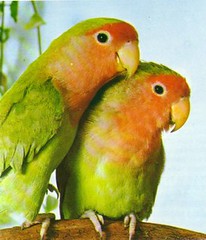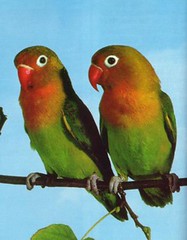tags: researchblogging.org, evolutionary behavior, sociobiology, ornithology, birds, avian, evolution, William Dilger, Agapornis roseicollis, Agapornis fischeri, lovebirds
Peach-faced lovebirds, Agapornis roseicollis (left)
and Fischer's lovebirds, Agapornis fischeri (right),
can interbreed to produce sterile offspring.
Images: LoveBirds New Zealand.
Is behavior genetically "programmed" or is it the result of learning? Or is it instead a little bit of both? This is the old "nature versus nurture" argument that has occupied behavioral and evolutionary scientists, psychologists and even the general public for decades. Interestingly, nearly 50 years ago, a series of elegant experiments by an ornithologist and aviculturist revealed that, in lovebirds, at least, nest-building behavior has a very strong genetic component combined with surprisingly little experiential modification.
William Dilger, a professor of ornithology at Cornell University, studied lovebirds for many years as he sought to learn more about the evolution of breeding and social behaviors, especially to understand which components of these behaviors are inherited and which are learned. Further, he determined the evolutionary relationships between these birds based on the complexity of their behaviors.
His subjects, the lovebirds, are a group of small short-tailed parrots in the genus Agapornis that are endemic to Africa and the island of Madagascar. Lovebirds were so named because breeding pairs typically feed each other to re-establish their pair bonds after experiencing separation or stress. This feeding behavior, where one bird transfers food from its mouth to that of its mate, resembles kissing in humans, thus earning them their name. Fortunately, several species of lovebirds have been and continue to be popular pets and breeding subjects for aviculturists throughout America and Europe, so they are easy to propogate and to study in captivity.
During the course of his many studies, Dilger noted that even though lovebirds are closely related, different species use different strategies to collect materials and carry them to a pre-selected tree hole where they then constructed their nests. For example, Fisher's lovebirds, Agapornis fischeri, carry single strips of tree bark in their beaks whereas peach-faced lovebirds, Agapornis roseicollis, tuck many pieces of tree bark into their flank and rump feathers before carrying them to their nest hole. Because the peach-faced lovebird's behaviors are more complex, Dilger deemed this species' behavior to be ancestral to that of the Fischer's lovebird.
To determine whether this particular behavior was genetic or learned, Dilger hybridized Fischer's lovebirds with peach-faced lovebirds. Even though the resulting hybrids were sterile, the lovebird hybrids still showed breeding behavior and surprisingly, they displayed nesting behaviors that are intermediate between the two parental species.
In short, Dilger found that the hybrid lovebirds demonstrated a confused combination of the two nest material carrying strategies: initially, the young birds tucked the nest material (strips that they had chewed from a larger piece of paper) into their flank and rump feathers but failed to let go, so they pulled them out again and again, repeating this pattern many times. As the birds matured and gained experience over a period of three years, they eventually settled on carrying nest materials in their beaks, like their Fischer's lovebird parent. However, they still maintained a peculiar ritual associated with the tucking of nest materials, like that of their peach-faced lovebird parent, prior to flying off with the paper in their beaks. Typically, they would turn their heads toward their rumps but would not tuck the nest materials among their feathers, although occasionally they still tried to tuck the paper strips into their rump feathers. It is interesting to note that the hybrid birds eventually adopted the least complex (and most derived) behavior among those available to them.
Since lovebirds can breed at six months of age, even if these hybrid birds were fertile, they would have not lasted long in the wild (nor, probably in captivity) because they would not have been able to produce many (or any) offspring in their lifetimes due to the length of time required for them to learn how to circumvent a seemingly simple yet genetically programmed behavior, such as carrying nest materials to their nest hole. This research concisely demonstrates the difficulties involved with learning to use one innate behavior at the expense of another.
Because the hybrid lovebirds were sterile and thus, could not breed with either parental species nor with each other, Dilger was never able to determine whether this behavior was the result of a single gene or several. But Dilger's studies were so elegant that they helped to define this new field of evolutionary behavior.
Sources
Dilger, William. The Behavior of Lovebirds. Scientific American 206 (1), 89-98 (January 1962) [PDF]
Alcock, John. Animal Behavior: An Evolutionary Approach, 3rd Edition. (Sunderland, Mass.: Sinauer Associates; 1984) pp 32-33.



Fascinating, I have never read any nature-nurture research analyzing hybrids before, and thanks for the link to the pdf!
This is slightly off-topic, but how would you rate lovebirds as pets, any significant pros/cons to the species for a beginning bird owner?
I had a peach-f./fischer lovebird pair and FWIW I'll just pass along 2 interesting behaviors I observed:
1. the Fischer (female) loved taking baths in a bowl of water, but was afraid of running water and always avoided it; contrarily, the Peach-f.(male) only wanted to take baths under running water in a sink and avoided the water bowl for a long time, but did eventually use it after watching his mate enjoy it for months.
2. the Peach-f. was my first lovebird and very bonded to me; when I got Fischer several months later, the P-F was VERY jealous and on a couple of occasions when I had them out on the floor and was playing with the Fischer, the P-F went into a "broken-wing" display (as associated with killdeer and some other birds), hobbling around in a circle with one wing outstretched, apparently to get my attention back (at which point he stopped) -- I was absolutely amazed to see this spontaneous behavior in a small captive-raised psitticine bird!
what a great article for me to share with the psych students. i am looking for convenient and "objective" activities for students to use in studying psych theory. birds would be brilliant!
This behavior is consistant with findings when crossing many similar species. Even Mendel found that crossing different species of pea plants that had different colored flowers, some exhibited the color of one species, some the color of the second, but in some crossings, the color was an intermediary of the two.
Many species of dogs are interbred to reduce aggression or increase athletic ability. Although they can then be taught to behave in the manner of one of their parents, their behavior is inately intermediary.
This is one of the better accounts of the work that I've read - thank you for taking the time to post about it! Back in the day I had 2 female lovebirds, both peachies, one was hand raised and the other was parent raised.. it was an interesting (if small) study sample on behaviors.
my experience is ethnological, thus biased toward innate releasing mechanisms, ritualization, fixed action patterns, etc., of Lorenz et al. I believe that intelligence is really "cognition", not intellectual learning and human personality characteristics, but cognitive learning ability and memory. I study crows (AMCR; FICR) and do notice individual characteristics of behavior, due to different experiences and current stimuli? maybe a professional like you could shed light on this
good luck on your thesis!!!!!!!!!! ornithology needs you
amateur, Lehigh Valley, PA, USA
I have a set of Love birds named Watermelon and Cantaloupe and watermelon has black feet and Cantaloupe has white feet and cantaloupe is yellow with red face watermelon is green with peach face. They have been doing the feeding and connecting becks. They fight a lot connecting becks and Watermelon get on Cantaloupe back most of the time. The person I bought them from when see gave them to me about two months ago she said they where about a month old. I don't know if they are breeding and I'm trying to learn them. They seem to be getting use to my husband and I but we don't exactly know if we should get a box for eggs or if it's just a thing. Please help us. They eat well fresh brocoli Spinach, and their seeds and I keep them with a clean cage and clean water. Just hope I'm doing the right thing.
Lovebirds are amazing little creatures! I have two peachies and one of them seems exceptionally smart! It's amazing how they can sense if you're coming to get them to put them in their cage or to get them just for fun! They know! They know when you're getting ready to leave the house. My one lovie will sit perfectly still near or behind a toy....knowing he won't be seen there, when he knows someone is getting him to put him back in his cage! Smart little stinkers!Lovebirds have such a love of life and having fun! especially cute is that they seem to have no concept of size when it comes to other birds or animals. My lovie is totally in love with a bird five times his size! Nope, there's no prejudice against birds who are different in the lovie world!
can i keep all 5 baby birds in one large cage ? (brother and sisters)